Recent Advances in Photo-Responsive Microencapsulated Phase-Change Materials
Abstract
1. Introduction
2. Microencapsulated Phase-Change Materials (MEPCMs)
3. Photothermal Conversion MEPCMs
3.1. Carbon-Based Photothermal Materials Integrated with MEPCMs
3.2. Organic Photothermal Materials Integrated with MEPCMs
3.3. Metal-Based Photothermal Materials Integrated with MEPCMs
3.4. Other Photothermal Materials Integrated with MEPCMs
4. Photocatalytic MEPCMs
5. Photoluminescence MEPCMs
6. Conclusions and Outlook
- Trade-off between functional material loading and energy storage performance. Although photo-responsive components enhance light responsiveness, they do not directly contribute to the phase-change process. Excessive loading will significantly reduce the overall energy storage density.
- High cost and complex fabrication processes. Most photo-responsive materials currently employed are expensive and require delicate synthesis and surface modification steps, making large-scale preparation of stable microcapsules technically demanding. As a result, most studies remain at the laboratory or proof-of-concept stage.
- Interfacial compatibility among components. The mismatch between the core–shell structure and photo-responsive fillers can lead to leakage or degradation during thermal cycling. Improving interfacial bonding via surface modification, coupling agents, or gradient-interface engineering will enhance durability.
- Limited multifunctional integration. Current studies primarily focus on the development of single- or dual-function MEPCMs. Future research should aim to achieve three or more functional properties by incorporating multiple types of functional materials.
- Scalability and practical implementation. The industrial deployment of photo-responsive MEPCMs still faces challenges in terms of large-scale synthesis, process costs, and long-term reliability. Simplifying fabrication routes, improving encapsulation efficiency, and adopting environmentally sustainable methods will be essential to enable scalable production and real-world integration.
Author Contributions
Funding
Data Availability Statement
Conflicts of Interest
Abbreviations
| ACQ | Aggregation-caused quenching |
| BS | Butyl stearate |
| CA | Capric acid |
| CB | Carbon black |
| CDQs | Carbon quantum dots |
| CNC | Cellulose nanocrystal |
| CNT | Carbon nanotube |
| CS | Chitosan |
| CTAB | Cetyl trimethyl ammonium bromide |
| DPP | Diketopyrrolopyrrole |
| DSC | Differential scanning calorimetry |
| EC | Ethyl cellulose |
| GO | Graphene oxide |
| HF | Hydrofluoric acid |
| HLB | Hydrophilic and lipophilic balance |
| ICG | Indocyanine green |
| LA | Lauric acid |
| LHS | Latent heat storage |
| LSPR | Localized surface plasmon resonance |
| LTH | Light-to-hydrogen |
| MB | Methylene blue |
| MEPCMs | Microencapsulated phase-change materials |
| MF | Melamine-formaldehyde |
| MIP | Molecularly imprinted polymer |
| NG | Nano-graphite |
| PA | Paraffin |
| PANI | Polyaniline |
| PB | Prussian blue |
| PCMs | Phase-change materials |
| PDA | Polydopamine |
| PMMA | Polymethyl methacrylate |
| PPY | Polypyrrole |
| PS | Polystyrene |
| PU | Polyurethane |
| PUA | Polyurethane acrylates |
| PVP | Polyvinylpyrrolidone |
| RhB | Rhodamine B |
| rGO | Reduced graphene oxide |
| SDB | Styrene divinylbenzene |
| SDBS | Sodium dodecyl-benzenesulfonate |
| SHS | Sensible heat storage |
| TCHS | Thermal chemical heat storage |
| TEOS | Tetraethoxysilane |
| TES | Thermal energy storage |
| UF | Urea-formaldehyde |
| Vis-NIR | Visible-to-near-infrared |
References
- Borge-Diez, D. Energy Policy, Energy Research, and Energy Politics: An Analytical Review of the Current Situation. Energies 2022, 15, 8792. [Google Scholar] [CrossRef]
- Rode, A.; Carleton, T.; Delgado, M.; Greenstone, M.; Houser, T.; Hsiang, S.; Hultgren, A.; Jina, A.; Kopp, R.E.; McCusker, K.E.; et al. Estimating a social cost of carbon for global energy consumption. Nature 2021, 598, 308–314. [Google Scholar] [CrossRef] [PubMed]
- Jafarizadeh, H.; Soltani, M.; Alfraidi, W. A comprehensive Thermoeconomic assessment of liquid air and compressed air energy storage with solid/liquid/hybrid thermal energy storage (TES): Addressing air and TES material storage cost impacts. Appl. Energy 2025, 388, 125615. [Google Scholar] [CrossRef]
- Sifnaios, I.; Sneum, D.M.; Jensen, A.R.; Fan, J.; Bramstoft, R. The impact of large-scale thermal energy storage in the energy system. Appl. Energy 2023, 349, 121663. [Google Scholar] [CrossRef]
- Zhang, P.; Ma, F.; Xiao, X. Thermal energy storage and retrieval characteristics of a molten-salt latent heat thermal energy storage system. Appl. Energy 2016, 173, 255–271. [Google Scholar] [CrossRef]
- Ghaib, K. Latent Heat Storage: Storage Materials, Heat Transfer, and Applications. Chem. Ing. Tech. 2017, 89, 1115–1125. [Google Scholar] [CrossRef]
- Zhang, C.; Huang, Y.; Chen, Y. Bionic study on latent heat thermal storage. Renew. Sustain. Energy Rev. 2023, 183, 113529. [Google Scholar] [CrossRef]
- Rezaei, E.; Barbato, M.; Ortona, A.; Haussener, S. Design and optimization of a high-temperature latent heat storage unit. Appl. Energy 2020, 261, 114330. [Google Scholar] [CrossRef]
- Lu, J.; Zhang, T.; Xu, Z.; Zhao, Y. Octodecane-cellulose nanofiber flexible composites for latent heat storage. Chem. Eng. J. 2021, 425, 131432. [Google Scholar] [CrossRef]
- Jafarian, M.; Arjomandi, M.; Nathan, G.J. A hybrid solar and chemical looping combustion system for solar thermal energy storage. Appl. Energy 2013, 103, 671–678. [Google Scholar] [CrossRef]
- Zhao, J.; Korba, D.; Mishra, A.; Klausner, J.; Randhir, K.; AuYeung, N.; Li, L. Particle-based high-temperature thermochemical energy storage reactors. Prog. Energy Combust. Sci. 2024, 102, 101143. [Google Scholar] [CrossRef]
- Zhou, Y.; Zhou, Z.; Sun, J.; Liu, L.; Luo, F.; Xu, G.; Cao, X.E.; Xu, M. Ruddlesden-Popper-type perovskite Sr3Fe2O7−δ for enhanced thermochemical energy storage. EcoMat 2023, 5, e12347. [Google Scholar] [CrossRef]
- Sommer, W.; Valstar, J.; Leusbrock, I.; Grotenhuis, T.; Rijnaarts, H. Optimization and spatial pattern of large-scale aquifer thermal energy storage. Appl. Energy 2015, 137, 322–337. [Google Scholar] [CrossRef]
- Zhao, Y.; Song, J.; Liu, M.; Zhao, Y.; Olympios, A.V.; Sapin, P.; Yan, J.; Markides, C.N. Thermo-economic assessments of pumped-thermal electricity storage systems employing sensible heat storage materials. Renew. Energy 2022, 186, 431–456. [Google Scholar] [CrossRef]
- Seyitini, L.; Belgasim, B.; Enweremadu, C.C. Solid state sensible heat storage technology for industrial applications—A review. J. Energy Storage 2023, 62, 106919. [Google Scholar] [CrossRef]
- Mishra, R.K.; Verma, K.; Mishra, V.; Chaudhary, B. A review on carbon-based phase change materials for thermal energy storage. J. Energy Storage 2022, 50, 104166. [Google Scholar] [CrossRef]
- Nazir, H.; Batool, M.; Osorio, F.J.B.; Isaza-Ruiz, M.; Xu, X.H.; Vignarooban, K.; Phelan, P.; Inamuddin; Kannan, A.M. Recent developments in phase change materials for energy storage applications: A review. Int. J. Heat Mass Transfer 2019, 129, 491–523. [Google Scholar] [CrossRef]
- Sun, M.Y.; Liu, T.; Sha, H.A.; Li, M.L.; Liu, T.Z.; Wang, X.L.; Chen, G.J.; Wang, J.D.; Jiang, D.Y. A review on thermal energy storage with eutectic phase change materials: Fundamentals and applications. J. Energy Storage 2023, 68, 107713. [Google Scholar] [CrossRef]
- Usman, A.; Xiong, F.; Aftab, W.; Qin, M.L.; Zou, R.Q. Emerging Solid-to-Solid Phase-Change Materials for Thermal-Energy Harvesting, Storage, and Utilization. Adv. Mater. 2022, 34, 2202457. [Google Scholar] [CrossRef]
- Rostami, S.; Afrand, M.; Shahsavar, A.; Sheikholeslami, M.; Kalbasi, R.; Aghakhani, S.; Shadloo, M.S.; Oztop, H.F. A review of melting and freezing processes of PCM/nano-PCM and their application in energy storage. Energy 2020, 211, 118698. [Google Scholar] [CrossRef]
- Li, X.; Liu, Y.; Xu, Y.; Tao, P.; Deng, T. Solid–Liquid Phase Change Composite Materials for Direct Solar–Thermal Energy Harvesting and Storage. Acc. Mater. Res. 2023, 4, 484–495. [Google Scholar] [CrossRef]
- Su, W.G.; Darkwa, J.; Kokogiannakis, G. Review of solid-liquid phase change materials and their encapsulation technologies. Renew. Sustain. Energy Rev. 2015, 48, 373–391. [Google Scholar] [CrossRef]
- Liu, L.; Alva, G.; Huang, X.; Fang, G. Preparation, heat transfer and flow properties of microencapsulated phase change materials for thermal energy storage. Renew. Sustain. Energy Rev. 2016, 66, 399–414. [Google Scholar] [CrossRef]
- Németh, B.; Németh, Á.S.; Ujhidy, A.; Tóth, J.; Trif, L.; Jankovics, H.; Kriszt, B.; Dobolyi, C.; May, Z.; Gyenis, J.; et al. Antimicrobial functionalization of Ca alginate-coconut oil latent heat storing microcapsules by Ag nanoparticles. Int. J. Energy Res. 2020, 44, 11998–12014. [Google Scholar] [CrossRef]
- Li, Y.; Jiang, Z.; He, F.; Chen, Z.; Li, X.; Wang, P.; He, G.; Zhu, X.; Yang, W. Reversible thermochromic microcapsules with SiO2 shell for indicating temperature and thermoregulation. J. Energy Storage 2023, 72, 108674. [Google Scholar] [CrossRef]
- Ke, W.-D.; Wu, X.-W.; Zhang, J.-L. In situ polymerization of organic and inorganic phase change microcapsule and enhancement of infrared stealth via nano iron. Colloids Surf. A 2021, 627, 127124. [Google Scholar] [CrossRef]
- Shen, H.; Zheng, Z.; Liu, H.; Wang, X. A solar-powered interfacial evaporation system based on MoS2-decorated magnetic phase-change microcapsules for sustainable seawater desalination. J. Mater. Chem. A 2022, 10, 25509–25526. [Google Scholar] [CrossRef]
- Tang, Z.D.; Gao, H.Y.; Chen, X.; Zhang, Y.F.; Li, A.; Wang, G. Advanced multifunctional composite phase change materials based on photo-responsive materials. Nano Energy 2021, 80, 105454. [Google Scholar] [CrossRef]
- Jiang, Z.; Yang, W.; He, F.; Xie, C.; Fan, J.; Wu, J.; Zhang, K. Modified Phase Change Microcapsules with Calcium Carbonate and Graphene Oxide Shells for Enhanced Energy Storage and Leakage Prevention. ACS Sustain. Chem. Eng. 2018, 6, 5182–5191. [Google Scholar] [CrossRef]
- Li, X.; Hu, M.; Liu, M.; Wang, Z.; Yu, J.; Guo, J. Preparation of hydrated calcium silicate phase change microcapsules and its application of temperature regulation in deep-water natural gas hydrate layer cementing process. Constr. Build. Mater. 2024, 428, 136413. [Google Scholar] [CrossRef]
- Li, Y.; Xu, L.; Jiang, Z.; Li, Y.; He, F.; Zhang, K.; He, R.; Chen, Z.; Yang, W. Paraffin@poly(methyl methacrylate) Phase Change Microcapsules for Thermal Energy Storage and Temperature Regulation. ChemistrySelect 2023, 8, e202203857. [Google Scholar] [CrossRef]
- Yan, B.; Lu, H.; Li, M.; Wang, X.; Wang, Z.; Pi, M.; Cui, W.; Ran, R. Preparation of phase change microcapsules with high thermal storage and temperature sensitive for thermal management. J. Energy Storage 2023, 64, 107003. [Google Scholar] [CrossRef]
- Su, J.; Zhang, H.; Gong, Y.; Xu, Q.; Hou, M.; Xu, B. Fabrication and properties analysis of paraffin@TiO2/Ag phase change microcapsules for thermal energy storage and photocatalysis. Mater. Sci. Eng. B 2024, 301, 117150. [Google Scholar] [CrossRef]
- Chang, Z.J.; Wang, K.; Wu, X.H.; Lei, G.; Wang, Q.W.; Liu, H.; Wang, Y.L.; Zhang, Q. Review on the preparation and performance of paraffin-based phase change microcapsules for heat storage. J. Energy Storage 2022, 46, 103840. [Google Scholar] [CrossRef]
- Li, S.-Y.; Yan, T.; Wang, K.-W.; Xie, T.; Pan, W.-G. Paraffin wax@TiO2 phase change microcapsules in SiC-doped for solar energy conversion and thermal storage. Sol. Energy Mater. Sol. Cells 2025, 282, 113395. [Google Scholar] [CrossRef]
- Chen, C.; Fang, L.; Wang, Y.; Jiu, S.; Chen, Y. Mechanical, thermal and microscopic properties of gypsum matrix composites containing capric acid-palmitic acid/urea-formaldehyde microcapsules. Case Stud. Constr. Mater. 2023, 18, e02084. [Google Scholar] [CrossRef]
- Ma, J.; Liu, H.; Sun, D.; Wang, J.; Cui, S. Synthesis of phase change microcapsules with binary fatty acid ester core and their feasibility investigation in energy conservation of cementitious materials. Constr. Build. Mater. 2022, 330, 127212. [Google Scholar] [CrossRef]
- Feng, Y.; Sun, S.-L.; Yu, S.-B.; Lin, C.-H.; Ning, Y.-H.; Li, Q.; Zhang, Y.-H.; Zhou, M.; Li, Y.-T.; Wang, S.-F.; et al. Effects of in-situ acid dopants on the latent heat storage properties and morphology of palmitic acid @ polyaniline microencapsulated phase change materials. Colloids Surf. A 2022, 647, 129207. [Google Scholar] [CrossRef]
- Gulfam, R.; Zhang, P.; Meng, Z. Advanced thermal systems driven by paraffin-based phase change materials – A review. Appl. Energy 2019, 238, 582–611. [Google Scholar] [CrossRef]
- Zhang, Z.; Lian, Y.; Xu, X.; Xu, X.; Fang, G.; Gu, M. Synthesis and characterization of microencapsulated sodium sulfate decahydrate as phase change energy storage materials. Appl. Energy 2019, 255, 113830. [Google Scholar] [CrossRef]
- Wang, K.; Zhang, T.; Wang, T.; Xu, C.; Ye, F.; Liao, Z. Microencapsulation of high temperature metallic phase change materials with SiCN shell. Chem. Eng. J. 2022, 436, 135054. [Google Scholar] [CrossRef]
- Wang, S.; Lei, K.; Wang, Z.; Wang, H.; Zou, D. Metal-based phase change material (PCM) microcapsules/nanocapsules: Fabrication, thermophysical characterization and application. Chem. Eng. J. 2022, 438, 135559. [Google Scholar] [CrossRef]
- Kawaguchi, T.; Nakamura, T.; Kondo, M.; Chidiebere Mba, J.; Dong, K.; Shimizu, Y.; Jeem, M.; Nomura, T. Microencapsulation of Zn-10 mass% Al alloy phase change material via dry synthesis method. Chem. Eng. J. 2024, 498, 154782. [Google Scholar] [CrossRef]
- Wang, K.; Tao, K.; Guo, M.; Wang, T.; Liao, Z.; Ye, F.; Xu, C.; Du, X. Thermal and cyclic performance of aluminum alloy composite phase change microcapsules for high-temperature thermal energy storage. Sol. Energy Mater. Sol. Cells 2024, 277, 113128. [Google Scholar] [CrossRef]
- Gu, M.; Huang, Y.; Bao, K.; Wang, L.; Huang, T.; Li, Y.; Cheng, X. Efficient preparation of GO-modified regular spherical SiO2@CaCl2·6H2O phase change microcapsules for enhanced thermal energy storage. J. Energy Storage 2024, 83, 110727. [Google Scholar] [CrossRef]
- Zhang, X.; Yang, Y.; Zhong, C.; Xiang, D.; Sun, H.; Li, D.; Yan, G.; Wu, Y. High-Performance Phase Change Films Prepared by a Strategy for Thermal Management at Interfaces and Environmental Camouflage. Small 2025, 21, 2500683. [Google Scholar] [CrossRef]
- Raj, C.R.; Suresh, S.; Bhavsar, R.R.; Kumar Singh, V.; Reddy, S. Effect of nano-gallium capsules on thermal energy storage characteristics of manganese organometallic SS-PCM. Thermochim. Acta 2019, 680, 178341. [Google Scholar] [CrossRef]
- Bao, J.; Zou, D.; Zhu, S.; Ma, Q.; Wang, Y.; Hu, Y. A medium-temperature, metal-based, microencapsulated phase change material with a void for thermal expansion. Chem. Eng. J. 2021, 415, 128965. [Google Scholar] [CrossRef]
- Sheng, N.; Lu, J.; Hu, J.; Zhu, R.; Fadillah, L.; Wang, C.; Zhu, C.; Rao, Z.; Habazaki, H. Synthesis of Sn@SnO2 core-shell microcapsules by a self-oxidation strategy for medium temperature thermal storage. Chem. Eng. J. 2021, 420, 129906. [Google Scholar] [CrossRef]
- Zhu, C.; Liu, R.; Lu, J.; Sheng, N. Preparation of Microencapsulated Low-Melting-Point Sn–Bi Alloy for Latent Heat Storage. Energy Technol. 2022, 11, 2201068. [Google Scholar] [CrossRef]
- Gokon, N.; Jie, C.S.; Nakano, Y.; Okazaki, S.; Kodama, T.; Hatamachi, T.; Bellan, S. Phase Change Material of Copper–Germanium Alloy as Solar Latent Heat Storage at High Temperatures. Front. Energy Res. 2021, 9, 696213. [Google Scholar] [CrossRef]
- Nomura, T.; Yoolerd, J.; Sheng, N.; Sakai, H.; Hasegawa, Y.; Haga, M.; Akiyama, T. Al/Al2O3 core/shell microencapsulated phase change material for high-temperature applications. Sol. Energy Mater. Sol. Cells 2019, 193, 281–286. [Google Scholar] [CrossRef]
- Han, C.; Gu, H.; Zhang, M.; Huang, A.; Zhang, Y.; Wang, Y. Al–Si @ Al2O3 @ mullite microcapsules for thermal energy storage: Preparation and thermal properties. Sol. Energy Mater. Sol. Cells 2020, 217, 110697. [Google Scholar] [CrossRef]
- Zhang, Z.; Zhang, Z.; Chang, T.; Wang, J.; Wang, X.; Zhou, G. Phase change material microcapsules with melamine resin shell via cellulose nanocrystal stabilized Pickering emulsion in-situ polymerization. Chem. Eng. J. 2022, 428, 131164. [Google Scholar] [CrossRef]
- Trivedi, G.V.N.; Parameshwaran, R. Cryogenic conditioning of microencapsulated phase change material for thermal energy storage. Sci. Rep. 2020, 10, 18353. [Google Scholar] [CrossRef]
- Li, F.; Sun, Z.; Jiao, S.; Ma, Y.; Zhang, Q.; Zhou, Y.; Wen, J.; Liu, Y. Preparation and Performance of Dual-functional Magnetic Phase-change Microcapsules. Chem. Asian J. 2020, 16, 102–109. [Google Scholar] [CrossRef]
- Chang, Y.; Sun, Z. Synthesis and thermal properties of n-tetradecane phase change microcapsules for cold storage. J. Energy Storage 2022, 52, 104959. [Google Scholar] [CrossRef]
- Wang, X.; Chen, Z.; Xu, W.; Wang, X. Capric acid phase change microcapsules modified with graphene oxide for energy storage. J. Mater. Sci. 2019, 54, 14834–14844. [Google Scholar] [CrossRef]
- Yan, J.; Ruan, L.; Hu, D.; Liu, W.; Chen, W.; Ma, W. Microencapsulation of Phase Change Materials with a Soy Oil-Based Polyurethane Shell via Pickering Emulsion Polymerization. ACS Appl. Energy Mater. 2023, 6, 6814–6825. [Google Scholar] [CrossRef]
- Li, C.; Fu, J.; Huang, F.; Zhu, Z.; Si, T. Controlled Latent Heat Phase-Change Microcapsules for Temperature Regulation. ACS Appl. Mater. Interfaces 2023, 15, 30383–30393. [Google Scholar] [CrossRef]
- Chen, L.; Lao, J.; Ma, J.; He, Z.; Fu, W.; Liu, J.; Peng, H.; Fang, T.; Luo, Y. Synthesis and properties of methyl palmitate-polyurea phase change microcapsules. Polymer 2025, 319, 128073. [Google Scholar] [CrossRef]
- Huang, H.; Shi, T.; He, R.; Wang, J.; Chu, P.K.; Yu, X.F. Phase-Changing Microcapsules Incorporated with Black Phosphorus for Efficient Solar Energy Storage. Adv. Sci. 2020, 7, 2000602. [Google Scholar] [CrossRef]
- Zhang, W.; Pan, R.; Yang, J.; Liu, M.; Yao, Y.; Zhang, A.; Gong, Y.; Gan, Z.; Hu, R.; Ding, J.; et al. Polystyrene shell-based “coconut-like” and “pomegranate-like” microencapsulated phase change materials: Formation mechanism, thermal conductivity/stability enhancement and their application in thermal management. Chem. Eng. J. 2024, 498, 155758. [Google Scholar] [CrossRef]
- Xu, C.; Gou, W.; Wang, X.; Zhou, J.; Liu, J.; Chen, K. Synthesis of paraffin@PS/reduced graphene oxide microcapsules via Pickering emulsion for multi-protective coatings. Colloids Surf. A 2021, 613, 126054. [Google Scholar] [CrossRef]
- Zhang, W.; Cheng, H.; Pan, R.; Yang, J.H.; Gong, Y.; Gan, Z.; Hu, R.; Ding, J.; Chen, L.; Zhang, X.; et al. Phase Change Microcapsules with a Polystyrene/Boron Nitride Nanosheet Hybrid Shell for Enhanced Thermal Management of Electronics. Langmuir 2022, 38, 16055–16066. [Google Scholar] [CrossRef] [PubMed]
- Chen, M.; Qian, Z.; Liu, H.; Wang, X. Size-tunable CaCO3@n-eicosane phase-change microcapsules for thermal energy storage. Colloids Surf. A 2022, 640, 128470. [Google Scholar] [CrossRef]
- Liu, H.; Tian, D.; Ouyang, M.; Qian, Z.; Wang, X. Morphology-controlled fabrication of magnetic phase-change microcapsules for synchronous efficient recovery of wastewater and waste heat. J. Colloid Interface Sci. 2022, 608, 1497–1513. [Google Scholar] [CrossRef]
- Zhang, M.; Shen, H.; Qian, Z.; Liu, H.; Tian, D.; Wang, X. Dual-purpose applications of magnetic phase-change microcapsules with crystalline-phase-tunable CaCO3 shell for waste heat recovery and heavy metal ion removal. J. Energy Storage 2022, 55, 105672. [Google Scholar] [CrossRef]
- Wang, B.; Shi, M.; Yao, H.; Yang, X.; Guo, S.; Liu, Y.; Hua, Q.; Shen, B.; Liu, P.; Tang, J. Preparation and application of low-temperature binary eutectic lauric acid-stearic acidSiO2 phase change microcapsules. Energy Build. 2023, 279, 112706. [Google Scholar] [CrossRef]
- Sun, Z.; Sun, K.; Zhang, H.; Liu, H.; Wu, D.; Wang, X. Development of poly(ethylene glycol)/silica phase-change microcapsules with well-defined core-shell structure for reliable and durable heat energy storage. Sol. Energy Mater. Sol. Cells 2021, 225, 111069. [Google Scholar] [CrossRef]
- Sun, Z.; Han, Z.; Liu, H.; Wu, D.; Wang, X. Nanoflaky nickel-hydroxide-decorated phase-change microcapsules as smart electrode materials with thermal self-regulation function for supercapacitor application. Renew. Energy 2021, 174, 557–572. [Google Scholar] [CrossRef]
- Zhu, H.; Li, M.; Yi, H.; Jia, F.; Xu, J.; Song, S. Paraffin@Hectorite-SiO2/Fe3O4 microcapsule phase change fluid for efficient photothermal energy storage and heat dissipation. Appl. Clay Sci. 2025, 271, 107797. [Google Scholar] [CrossRef]
- Cheng, H.; Tang, B.; Bao, H.Y.; Shan, F.; Lu, C.X. Preparation and application of high thermal conductivity phase change microcapsules with fluorescence characteristics based on a ZnWO4 shell. Nanoscale 2024, 16, 20331–20341. [Google Scholar] [CrossRef] [PubMed]
- Hu, T.; Zhang, J.; Xiao, R.; Wang, G.; Yu, W.; Su, H.; Su, L. Study on the preparation and properties of TiO2@n-octadecane phase change microcapsules for regulating building temperature. Appl. Therm. Eng. 2024, 249, 123429. [Google Scholar] [CrossRef]
- Li, M.; Liu, J.; Shi, J. Synthesis and properties of phase change microcapsule with SiO2-TiO2 hybrid shell. Sol. Energy 2018, 167, 158–164. [Google Scholar] [CrossRef]
- Chen, S.; Liu, H.; Wang, X. Pomegranate-like phase-change microcapsules based on multichambered TiO2 shell engulfing multiple n-docosane cores for enhancing heat transfer and leakage prevention. J. Energy Storage 2022, 51, 104406. [Google Scholar] [CrossRef]
- Wang, X.; Wu, Y.; Zou, F.; Jin, L.; Zhong, Y.; Ma, C. Thermal and photocatalytic properties of TiO2 hybrid phase change microcapsules. J. Energy Storage 2024, 102, 114164. [Google Scholar] [CrossRef]
- Wang, X.; Chen, H.; Kuang, D.; Huan, X.; Zeng, Z.; Qi, C.; Han, S.; Li, G. Unlocking thermal management capacity: Optimized organic-inorganic hybrid shell phase change microcapsules with controllable structure and enhanced conductivity. Compos. Sci. Technol. 2024, 257, 110836. [Google Scholar] [CrossRef]
- Hu, T.; Zhang, J.; Chan, W.; Xiao, R.; Xu, H.; Zhao, X.; Wang, G.; Yu, W. Synthesis and optimization of GO/TiO2@n-octadecane microcapsules for thermal management of smartphone charging. Appl. Therm. Eng. 2024, 257, 124409. [Google Scholar] [CrossRef]
- Paswan, R.; Das, S. Elucidating the evolution of pore structure, microstructural damage, and micromechanical response in cement pastes containing microencapsulated phase change materials under freeze-thaw conditions. Cem. Concr. Compos. 2024, 154, 105743. [Google Scholar] [CrossRef]
- Yao, C.; Yu, X.; Feng, L.; Wang, F.; Wang, M.; Yuan, Q. Development of microencapsulated phase change material slurry for diamond wire sawing silicon wafer and its effect on cutting quality. J. Manuf. Process. 2024, 127, 421–432. [Google Scholar] [CrossRef]
- Sun, W.; Zhang, Z.; Zhang, Z.; He, N.; Wei, Q.; Feng, L.; Wang, Z.; Wu, J.; Liu, C.; Fu, S.; et al. Photothermal phase change material microcapsules via cellulose nanocrystal and graphene oxide co-stabilized Pickering emulsion for solar and thermal energy storage. Sci. China Mater. 2024, 67, 3225–3235. [Google Scholar] [CrossRef]
- Gu, B.; Li, G.; Zhang, Q.; Pan, H.; Duan, M.; Weng, L.; Zhao, D. A Novel Method for Increasing Phase-Change Microcapsules in Nanofiber Textile through Electrospinning. Adv. Funct. Mater. 2024, 35, 2412089. [Google Scholar] [CrossRef]
- Sun, L.; Wang, Y.; Chen, L.; Ying, J.; Li, Q.; Fu, L.; Yan, Q.; Wu, K.; Xue, C.; Yu, J.; et al. van der Waals-bonded graphene clusters enhance thermal conductivity of phase-change materials for advanced thermal energy management. Mater. Horiz. 2024, 11, 5031–5044. [Google Scholar] [CrossRef] [PubMed]
- Jing, J.; Liu, H.; Wang, X. Multifunctional BiOI/SiO2/Fe3O4@n-Docosane Phase-Change Microcapsules for Waste Heat Recovery and Wastewater Treatment. Materials 2023, 16, 1656. [Google Scholar] [CrossRef]
- Wang, M.; Liu, G.; Gao, H.; Su, C.; Gao, J. Preparation and performance of reversible thermochromic phase change microcapsules based on negative photochromic spiropyran. Colloids Surf. A 2023, 659, 130808. [Google Scholar] [CrossRef]
- Cheng, P.F.; Wang, D.; Schaaf, P. A Review on Photothermal Conversion of Solar Energy with Nanomaterials and Nanostructures: From Fundamentals to Applications. Adv. Sustain. Syst. 2022, 6, 2200115. [Google Scholar] [CrossRef]
- Liu, H.; Wang, X.; Wu, D. Fabrication of Graphene/TiO2/Paraffin Composite Phase Change Materials for Enhancement of Solar Energy Efficiency in Photocatalysis and Latent Heat Storage. ACS Sustain. Chem. Eng. 2017, 5, 4906–4915. [Google Scholar] [CrossRef]
- Yu, Y.; He, L.; Lu, P.; Yuan, Y.; Zhang, H. Preparation, performances and applications of multi-functional photoluminescence form-stable phase change materials. Polymer 2020, 189, 122211. [Google Scholar] [CrossRef]
- Cui, X.M.; Ruan, Q.F.; Zhu, X.L.; Xia, X.Y.; Hu, J.T.; Fu, R.F.; Li, Y.; Wang, J.F.; Xu, H.X. Photothermal Nanomaterials: A Powerful Light-to-Heat Converter. Chem. Rev. 2023, 123, 6891–6952. [Google Scholar] [CrossRef]
- Li, Z.J.; Lei, H.; Kan, A.K.; Xie, H.Q.; Yu, W. Photothermal applications based on graphene and its derivatives: A state-of-the-art review. Energy 2021, 216, 119262. [Google Scholar] [CrossRef]
- Ren, J.; Hu, T.; Zhang, W.; Li, L.; Yuan, W. Enhanced photo-thermal conversion in phase change materials by Cu-Zn Bi-metallic metal-organic framework and expanded graphite. Sol. Energy Mater. Sol. Cells 2025, 281, 113326. [Google Scholar] [CrossRef]
- Li, A.; Huang, M.; Hu, D.; Tang, Z.; Xu, J.; Li, Y.; Zhang, X.; Chen, X.; Wang, G. Polydopamine-coated metal-organic framework-based composite phase change materials for photothermal conversion and storage. Chin. Chem. Lett. 2023, 34, 107916. [Google Scholar] [CrossRef]
- Li, J.; Chen, Y.; Xu, J.; Zhang, F. Preparation and energy storage application of polydopamine-modified silica phase change microcapsules. Mater. Today Commun. 2025, 46, 112694. [Google Scholar] [CrossRef]
- Zeng, W.A.; Ye, X.Y.; Dong, Y.C.; Zhang, Y.Q.; Sun, C.Z.; Zhang, T.; Guan, X.J.; Guo, L.J. MXene for photocatalysis and photothermal conversion: Synthesis, physicochemical properties, and applications. Coord. Chem. Rev. 2024, 508, 215753. [Google Scholar] [CrossRef]
- Shi, L.; Huang, C.; Zheng, N.; Chen, J.; Ning, R.; Huang, Z.; Deng, N.; Fang, X.; Zhou, T.; Sun, Z. Thermal energy storage characteristics of carbon-based phase change composites for photo-thermal conversion. J. Energy Storage 2024, 77, 109892. [Google Scholar] [CrossRef]
- Shen, Y.; Skirtach, A.G.; Seki, T.; Yagai, S.; Li, H.; Möhwald, H.; Nakanishi, T. Assembly of Fullerene-Carbon Nanotubes: Temperature Indicator for Photothermal Conversion. J. Am. Chem. Soc. 2010, 132, 8566–8568. [Google Scholar] [CrossRef]
- Lim, D.-K.; Barhoumi, A.; Wylie, R.G.; Reznor, G.; Langer, R.S.; Kohane, D.S. Enhanced Photothermal Effect of Plasmonic Nanoparticles Coated with Reduced Graphene Oxide. Nano Lett. 2013, 13, 4075–4079. [Google Scholar] [CrossRef]
- Prasher, R. Graphene Spreads the Heat. Science 2010, 328, 185–186. [Google Scholar] [CrossRef]
- Li, J.; Jia, L.; Li, L.; Huang, Z.; Chen, Y. Hybrid Microencapsulated Phase-Change Material and Carbon Nanotube Suspensions toward Solar Energy Conversion and Storage. Energies 2020, 13, 4401. [Google Scholar] [CrossRef]
- Chen, S.; Zheng, Z.; Liu, H.; Wang, X. Highly Efficient, Antibacterial, and Salt-Resistant Strategy Based on Carbon Black/Chitosan-Decorated Phase-Change Microcapsules for Solar-Powered Seawater Desalination. ACS Appl. Mater. Interfaces 2023, 15, 16640–16653. [Google Scholar] [CrossRef]
- Yuan, K.; Chen, Q.; Zhang, A.; Xiao, N.; Zou, X.; Lin, Z. Efficient thermal energy conversion and storage enabled by hybrid graphite nanoparticles/silica-encapsulated phase-change microcapsules. J. Mater. Chem. A 2024, 12, 2456–2464. [Google Scholar] [CrossRef]
- Guo, S.; Gu, D.Y.; Yang, Y.; Tian, J.; Chen, X.Y. Near-infrared photodynamic and photothermal co-therapy based on organic small molecular dyes. J. Nanobiotechnol. 2023, 21, 348. [Google Scholar] [CrossRef]
- Kim, H.J.; Kim, B.; Auh, Y.; Kim, E. Conjugated Organic Photothermal Films for Spatiotemporal Thermal Engineering. Adv. Mater. 2021, 33, 2005940. [Google Scholar] [CrossRef]
- Yuan, S.; Yan, R.; Ren, B.; Du, Z.; Cheng, X.; Du, X.; Wang, H. Robust, double-layered phase-changing microcapsules with superior solar-thermal conversion capability and extremely high energy storage density for efficient solar energy storage. Renew. Energy 2021, 180, 725–733. [Google Scholar] [CrossRef]
- Zhang, Q.; Chen, Y.; Liu, R.; Luo, J. Efficiently all-weather anti-icing and de-icing coatings enabled by polyaniline microcapsules encapsulated phase change materials. Chem. Eng. J. 2024, 499, 156122. [Google Scholar] [CrossRef]
- Li, M.; Chang, P.; Pan, Y. Preparation and performance improvement of poly-pyrrole modified yeast phase change microcapsules for photothermal energy conversion and storage. Sol. Energy 2025, 286, 113180. [Google Scholar] [CrossRef]
- Li, P.; Zou, F.; Wang, X.; Kamal Alebeid, O.; Zhao, T. In-situ deposition preparation of n-octadecane@Silica@Polydopamine-doped polypyrrole microcapsules for photothermal conversion and thermal energy storage of full-spectrum solar radiation. Sol. Energy 2022, 240, 388–398. [Google Scholar] [CrossRef]
- Li, X.; Jiang, H.; Ma, C.; Zhu, Z.; Song, X.; Wang, H.; Huo, P.; Li, X. Local surface plasma resonance effect enhanced Z-scheme ZnO/Au/g-C3N4 film photocatalyst for reduction of CO2 to CO. Appl. Catal. B 2021, 283, 119638. [Google Scholar] [CrossRef]
- Li, J.; Zhang, N.; Li, D.; Li, Y.; Zhang, W.; Zhao, Z.; Song, S.; Liu, Y.; Qin, L.; Bao, X.; et al. Construction of medium-entropy alloys coupled Z-Scheme heterojunction and its enhanced photocatalytic performance by regulating mechanism of LSPR effect. J. Mater. Sci. Technol. 2024, 197, 32–45. [Google Scholar] [CrossRef]
- Zhou, F.; Ma, Y.; Zhao, W.; Zhang, L.; Chen, Y.; Sheng, X. Integrating AgNPs-decorated phase change microcapsules into UV-cured PUA with enhanced thermal conductivity for solar thermal energy conversion and storage. Sol. Energy Mater. Sol. Cells 2025, 279, 113253. [Google Scholar] [CrossRef]
- Peng, S.; Zhong, W.; Zhao, H.; Wang, C.; Tian, Z.; Shu, R.; Chen, Y. Solar-driven multifunctional Au/TiO2@PCM towards bio-glycerol photothermal reforming hydrogen production and thermal storage. Int. J. Hydrogen Energy 2022, 47, 41573–41586. [Google Scholar] [CrossRef]
- Luo, W.; Zou, M.; Wang, J.; Ma, Y.; Hu, X.; Chen, W.; Jiang, X. Polypyrrole and Ag nanoparticles synergistically enhances the photothermal conversion performance of microencapsulated phase change energy storage materials in multiple way. Sol. Energy Mater. Sol. Cells 2025, 283, 113451. [Google Scholar] [CrossRef]
- Zhang, D.; Yang, A.-S.; Jiang, Z.; He, F.; Li, Y.; Li, X.; Chen, Z.; Yang, W. Paraffin@silica@poly(dopamine)/Silver Phase Change Microcapsules with Efficient Photothermal Conversion Performance. Energy Fuels 2023, 37, 16951–16961. [Google Scholar] [CrossRef]
- Naguib, M.; Kurtoglu, M.; Presser, V.; Lu, J.; Niu, J.; Heon, M.; Hultman, L.; Gogotsi, Y.; Barsoum, M.W. Two-Dimensional Nanocrystals Produced by Exfoliation of Ti3AlC2. Adv. Mater. 2011, 23, 4248–4253. [Google Scholar] [CrossRef]
- Alhabeb, M.; Maleski, K.; Mathis, T.S.; Sarycheva, A.; Hatter, C.B.; Uzun, S.; Levitt, A.; Gogotsi, Y. Selective Etching of Silicon from Ti3SiC2 (MAX) To Obtain 2D Titanium Carbide (MXene). Angew. Chem. Int. Ed. 2018, 57, 5444–5448. [Google Scholar] [CrossRef]
- Hantanasirisakul, K.; Gogotsi, Y. Electronic and Optical Properties of 2D Transition Metal Carbides and Nitrides (MXenes). Adv. Mater. 2018, 30, 1804779. [Google Scholar] [CrossRef]
- Naguib, M.; Barsoum, M.W.; Gogotsi, Y. Ten Years of Progress in the Synthesis and Development of MXenes. Adv. Mater. 2021, 33, 2103393. [Google Scholar] [CrossRef]
- Zhao, K.; Guo, Z.; Wang, J.; Xie, H. Enhancing solar photothermal conversion and energy storage with titanium carbide (Ti3C2) MXene nanosheets in phase-change microcapsules. J. Colloid Interface Sci. 2023, 650, 1591–1604. [Google Scholar] [CrossRef]
- Zhang, M.; Sun, K.; Zheng, Z.; Liu, H.; Wang, X. Development of MXene-decorated sodium alginate/SiO2@n-docosane hierarchical phase-change microcapsules for solar-driven sustainable seawater desalination. Desalination 2023, 550, 116380. [Google Scholar] [CrossRef]
- Lu, J.; Deng, Y.; Luo, D.; Wu, F.; Dai, X. Preparation and performance enhancement of MXene/Na2HPO4·12H2O@SiO2 phase change microcapsule. J. Energy Storage 2024, 91, 112079. [Google Scholar] [CrossRef]
- Gancheva, M.; Markova-Velichkova, M.; Atanasova, G.; Kovacheva, D.; Uzunov, I.; Cukeva, R. Design and photocatalytic activity of nanosized zinc oxides. Appl. Surf. Sci. 2016, 368, 258–266. [Google Scholar] [CrossRef]
- Arsha Kusumam, T.V.; Panakkal, T.; Divya, T.; Nikhila, M.P.; Anju, M.; Anas, K.; Renuka, N.K. Morphology controlled synthesis and photocatalytic activity of zinc oxide nanostructures. Ceram. Int. 2016, 42, 3769–3775. [Google Scholar] [CrossRef]
- Chen, H.; Liu, X.; Zhao, K.; Wang, J.; Xie, H. Preparation of PW@CaCO3 phase change microcapsules modified by ZnO nanoparticles with excellent photocatalytic and thermal properties. J. Energy Storage 2024, 77, 109942. [Google Scholar] [CrossRef]
- Kumar, R.; Abdel-Wahab, M.S.; Barakat, M.A.; Rashid, J.; Salah, N.; Al-Ghamdi, A.A. Role of N doping on the structural, optical and photocatalytic properties of the silver deposited ZnO thin films. J. Taiwan Inst. Chem. Eng. 2016, 69, 131–138. [Google Scholar] [CrossRef]
- Das, A.; Wary, R.R.; Nair, R.G. Mn-doped ZnO:Role of morphological evolution on enhanced photocatalytic performance. Energy Rep. 2020, 6, 737–741. [Google Scholar] [CrossRef]
- Nie, M.; Liao, J.; Cai, H.; Sun, H.; Xue, Z.; Guo, P.; Wu, M. Photocatalytic property of silver enhanced Ag/ZnO composite catalyst. Chem. Phys. Lett. 2021, 768, 138394. [Google Scholar] [CrossRef]
- Zhou, X.; Ai, C.; Wang, X.; Wu, Z.; Zhang, J. F− surface modified ZnO for enhanced photocatalytic H2O2 production and its fs-TAS investigation. J. Mater. 2025, 11, 100974. [Google Scholar] [CrossRef]
- Khanchandani, S.; Kundu, S.; Patra, A.; Ganguli, A.K. Shell Thickness Dependent Photocatalytic Properties of ZnO/CdS Core–Shell Nanorods. J. Phys. Chem. C 2012, 116, 23653–23662. [Google Scholar] [CrossRef]
- Cho, S.; Jang, J.-W.; Kim, J.; Lee, J.S.; Choi, W.; Lee, K.-H. Three-Dimensional Type II ZnO/ZnSe Heterostructures and Their Visible Light Photocatalytic Activities. Langmuir 2011, 27, 10243–10250. [Google Scholar] [CrossRef]
- Naseri, A.; Samadi, M.; Pourjavadi, A.; Ramakrishna, S.; Moshfegh, A.Z. Enhanced photocatalytic activity of ZnO/g-C3N4 nanofibers constituting carbonaceous species under simulated sunlight for organic dye removal. Ceram. Int. 2021, 47, 26185–26196. [Google Scholar] [CrossRef]
- Chen, X.; Xu, X.; Cui, J.; Chen, C.; Zhu, X.; Sun, D.; Qian, J. Visible-light driven degradation of tetracycline hydrochloride and 2,4-dichlorophenol by film-like N-carbon@N-ZnO catalyst with three-dimensional interconnected nanofibrous structure. J. Hazard. Mater. 2020, 392, 122331. [Google Scholar] [CrossRef]
- Yuan, Z.; Shi, X.; Chen, K. Preparation and characterization of chitosan/ZnO-Ag composite microcapsules and their applications in solar energy harvesting and electromagnetic interference shielding. Int. J. Biol. Macromol. 2024, 263, 130285. [Google Scholar] [CrossRef]
- Linsebigler, A.L.; Lu, G.; Yates, J.T., Jr. Photocatalysis on TiO2 Surfaces: Principles, Mechanisms, and Selected Results. Chem. Rev. 1995, 95, 735–758. [Google Scholar] [CrossRef]
- Armakovic, S.J.; Savanovic, M.M.; Armakovic, S. Titanium Dioxide as the Most Used Photocatalyst for Water Purification: An Overview. Catalysts 2023, 13, 26. [Google Scholar] [CrossRef]
- Zhao, K.; Guo, Z.; Wang, J.; Xie, H. Phase change n-Octadecane microencapsulated in titanium dioxide nanoparticle-doped polymer for photothermal conversion and photocatalysis. Sol. Energy 2023, 254, 73–87. [Google Scholar] [CrossRef]
- Zhao, A.; Xiao, X.; Hu, Z.-T.; Zhu, W.; Yang, J.; Yang, E.-H. Multifunctional F-doped TiO2 PCM microcapsules for visible-light-driven photocatalysis and latent heat storage. Appl. Energy 2024, 359, 122674. [Google Scholar] [CrossRef]
- Rawal, S.B.; Chakraborty, A.K.; Lee, W.I. Heterojunction of FeOOH and TiO2 for the formation of visible light photocatalyst. Bull. Korean Chem. Soc. 2009, 30, 2613–2616. [Google Scholar] [CrossRef]
- Amani-Ghadim, A.R.; Alizadeh, S.; Khodam, F.; Rezvani, Z. Synthesis of rod-like α-FeOOH nanoparticles and its photocatalytic activity in degradation of an azo dye: Empirical kinetic model development. J. Mol. Catal. A Chem. 2015, 408, 60–68. [Google Scholar] [CrossRef]
- Xu, B.; Wei, Z.; Hong, X.; Zhou, Y.; Gan, S.; Shen, M. Preparation and characterization of novel microencapsulated phase change materials with SiO2/FeOOH as the shell for heat energy storage and photocatalysis. J. Energy Storage 2021, 43, 103251. [Google Scholar] [CrossRef]
- Ren, K.; Yue, S.; Li, C.; Fang, Z.; Gasem, K.A.M.; Leszczynski, J.; Qu, S.; Wang, Z.; Fan, M. Metal halide perovskites for photocatalysis applications. J. Mater. Chem. A 2022, 10, 407–429. [Google Scholar] [CrossRef]
- DuBose, J.T.; Kamat, P.V. Efficacy of Perovskite Photocatalysis: Challenges to Overcome. ACS Energy Lett. 2022, 7, 1994–2011. [Google Scholar] [CrossRef]
- Zhang, H.; Ji, X.; Xu, H.; Zhang, R.; Zhang, H. Design and modification of perovskite materials for photocatalytic performance improvement. J. Environ. Chem. Eng. 2023, 11, 109056. [Google Scholar] [CrossRef]
- Kaur, J.; Peter, S.C. Two-Dimensional Perovskites for Photocatalytic CO2 Reduction. Angew. Chem. Int. Ed. 2025, 64, e202418708. [Google Scholar] [CrossRef]
- Lakshmanan, P.; Youk, J.H. A comprehensive review of carbon nitride-based catalysts for overall water splitting: Dimensional insights. Sustain. Mater.Technol. 2025, 45, e01483. [Google Scholar] [CrossRef]
- Fernandes, E.; Mazierski, P.; Miodyńska-Melzer, M.; Nikiforow, K.; Klimczuk, T.; Zaleska-Medynska, A.; Martins, R.C.; Gomes, J. Cerium oxide integration and oxygen doping of g-C3N4 for boosted solar removal of emerging pollutants and water disinfection. Chem. Eng. J. 2025, 521, 166993. [Google Scholar] [CrossRef]
- Liu, J.; Qi, K.; Xiang, X.; Jamal Sisi, A.; Khataee, A.; Xu, L. Covalent Organic Framework-Based Photocatalysts from Synthesis to Applications. Energy Environ. Mater. 2025, 8, e70071. [Google Scholar] [CrossRef]
- Zhang, J.; Li, X.; Hu, H.; Huang, H.; Li, H.; Sun, X.; Ma, T. Enhancing photocatalytic performance of covalent organic frameworks via ionic polarization. Nat. Commun. 2024, 15, 9576. [Google Scholar] [CrossRef]
- Wang, L.; Zhang, Y. Impact of Interfaces on the Performance of Covalent Organic Frameworks for Photocatalytic Hydrogen Production. Small 2024, 21, 2408395. [Google Scholar] [CrossRef]
- Jablonski, A. Efficiency of Anti-Stokes Fluorescence in Dyes. Nature 1933, 131, 839–840. [Google Scholar] [CrossRef]
- Khoee, S.; Zamani, S.; Tajik, M. An investigation into the role of polarity of diamines in controlling the electron migration mechanism of photoluminescent poly(amide–imide)s. Spectrochim. Acta Part A 2009, 72, 1054–1061. [Google Scholar] [CrossRef]
- Lu, S.; Sui, L.; Liu, J.; Zhu, S.; Chen, A.; Jin, M.; Yang, B. Near-Infrared Photoluminescent Polymer–Carbon Nanodots with Two-Photon Fluorescence. Adv. Mater. 2017, 29, 1603443. [Google Scholar] [CrossRef]
- Montini, T.; Gombac, V.; Hameed, A.; Felisari, L.; Adami, G.; Fornasiero, P. Synthesis, characterization and photocatalytic performance of transition metal tungstates. Chem. Phys. Lett. 2010, 498, 113–119. [Google Scholar] [CrossRef]
- Liu, X.; Guo, Z.; Wang, J.; Xie, H. Fluorescence and Thermal Regulation Using Low-Supercooling Inorganic Microencapsulated Phase-Change Materials. ACS Appl. Mater. Interfaces 2023, 15, 20444–20457. [Google Scholar] [CrossRef]
- Zhang, Y.; Wang, X.; Wu, D. Microencapsulation of n-dodecane into zirconia shell doped with rare earth: Design and synthesis of bifunctional microcapsules for photoluminescence enhancement and thermal energy storage. Energy 2016, 97, 113–126. [Google Scholar] [CrossRef]
- Wei, H.; He, F.; Li, Y.; Zhang, Q.; Zhou, Y.; Yan, H.; He, R.; Fan, J.; Yang, W. Bifunctional Paraffin@CaCO3:Ce3+ Phase Change Microcapsules for Thermal Energy Storage and Photoluminescence. ACS Sustain. Chem. Eng. 2019, 7, 18854–18862. [Google Scholar] [CrossRef]
- Liu, H.; Shen, H.; Zhang, H.; Wang, X. Development of photoluminescence phase-change microcapsules for comfort thermal regulation and fluorescent recognition applications in advanced textiles. J. Energy Storage 2022, 49, 104158. [Google Scholar] [CrossRef]
- Otaegui, J.R.; Ruiz-Molina, D.; Hernando, J.; Roscini, C. Multidimensional Data Encoding Based on Multicolor Microencapsulated Thermoresponsive Fluorescent Phase Change Materials. Adv. Funct. Mater. 2024, 34, 2402510. [Google Scholar] [CrossRef]
- Du, J.; Sheng, L.; Chen, Q.; Xu, Y.; Li, W.; Wang, X.; Li, M.; Zhang, S.X.-A. Simple and general platform for highly adjustable thermochromic fluorescent materials and multi-feasible applications. Mater. Horiz. 2019, 6, 1654–1662. [Google Scholar] [CrossRef]
- Yu, J.; Liu, H.; Wang, Y.; Li, J.; Wu, D.; Wang, X. Fluorescent sensing system based on molecularly imprinted phase-change microcapsules and carbon quantum dots for high-efficient detection of tetracycline. J. Colloid Interface Sci. 2021, 599, 332–350. [Google Scholar] [CrossRef]

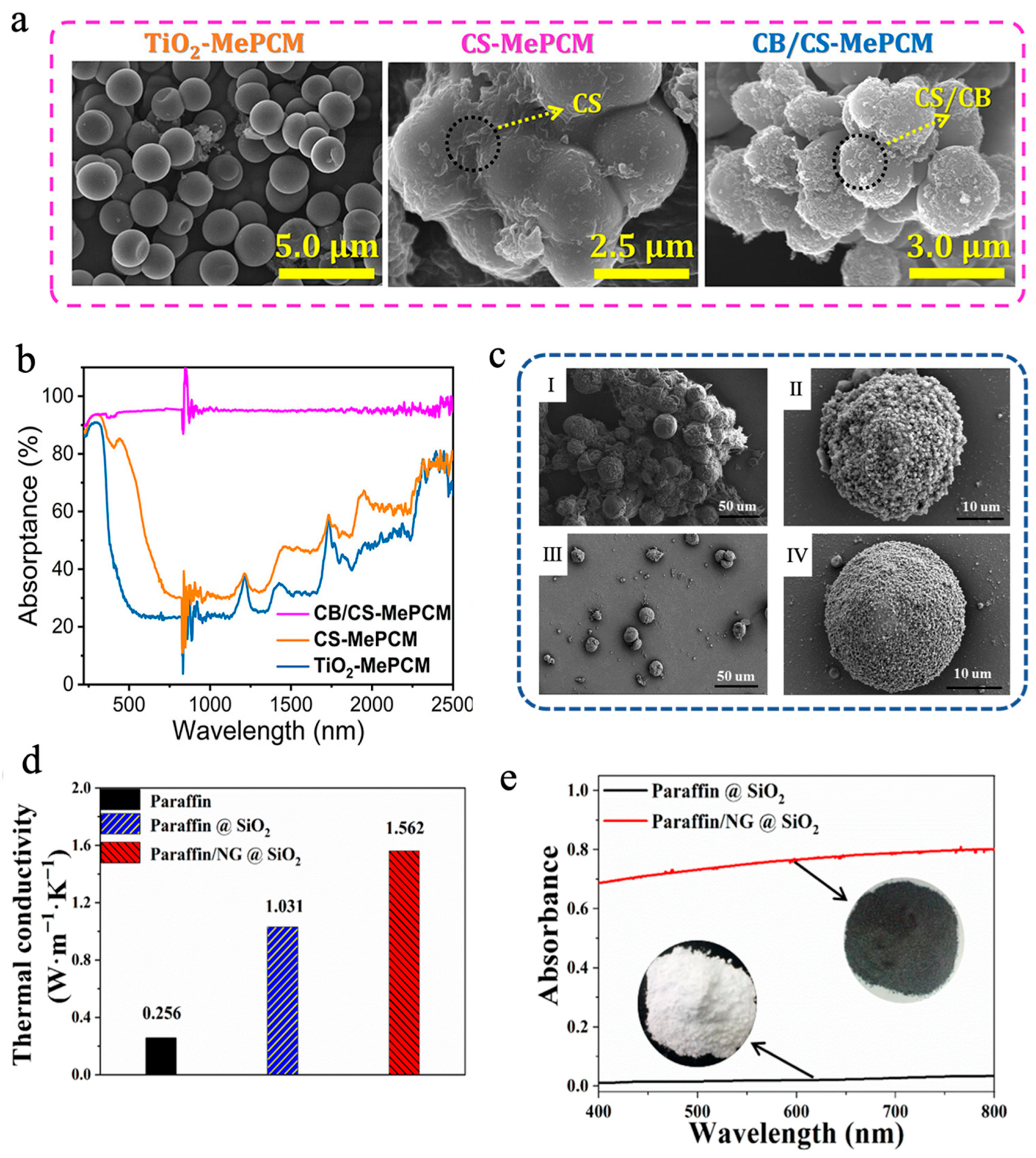
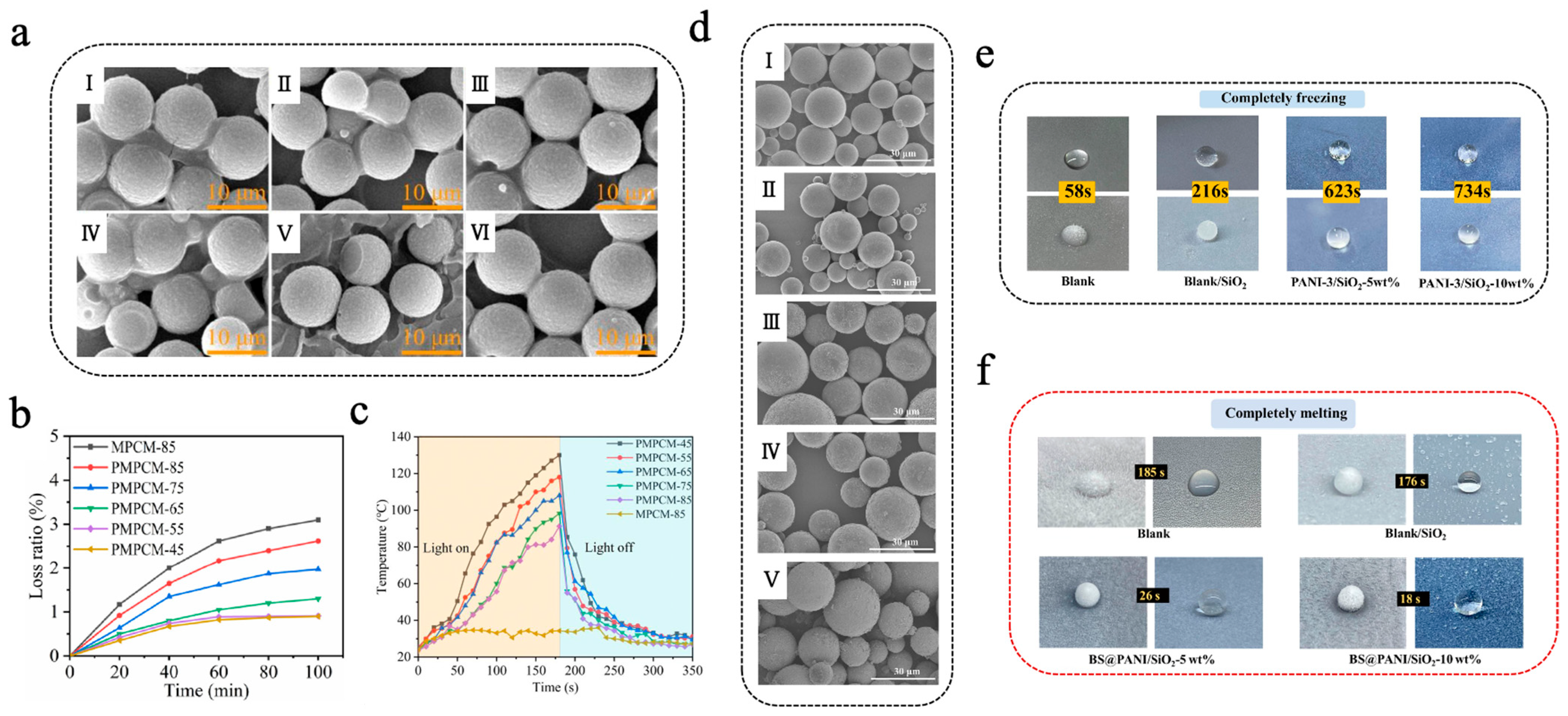

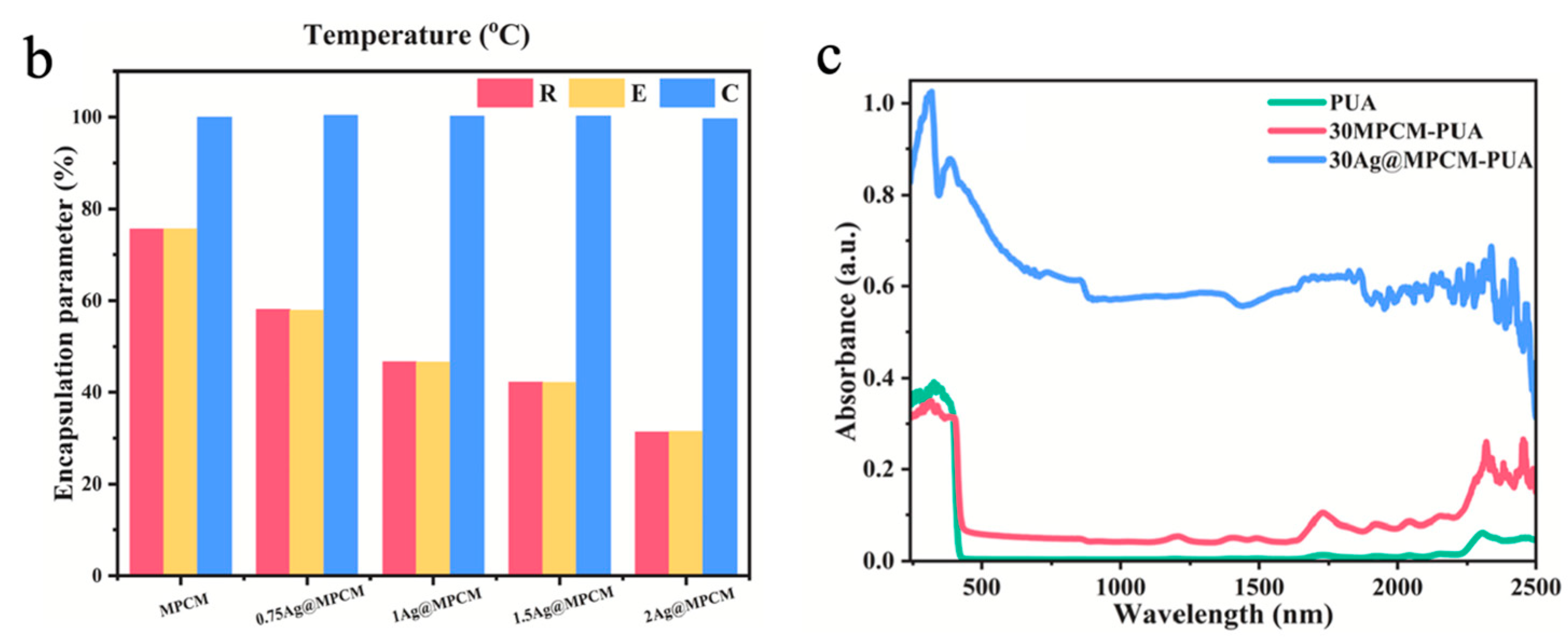

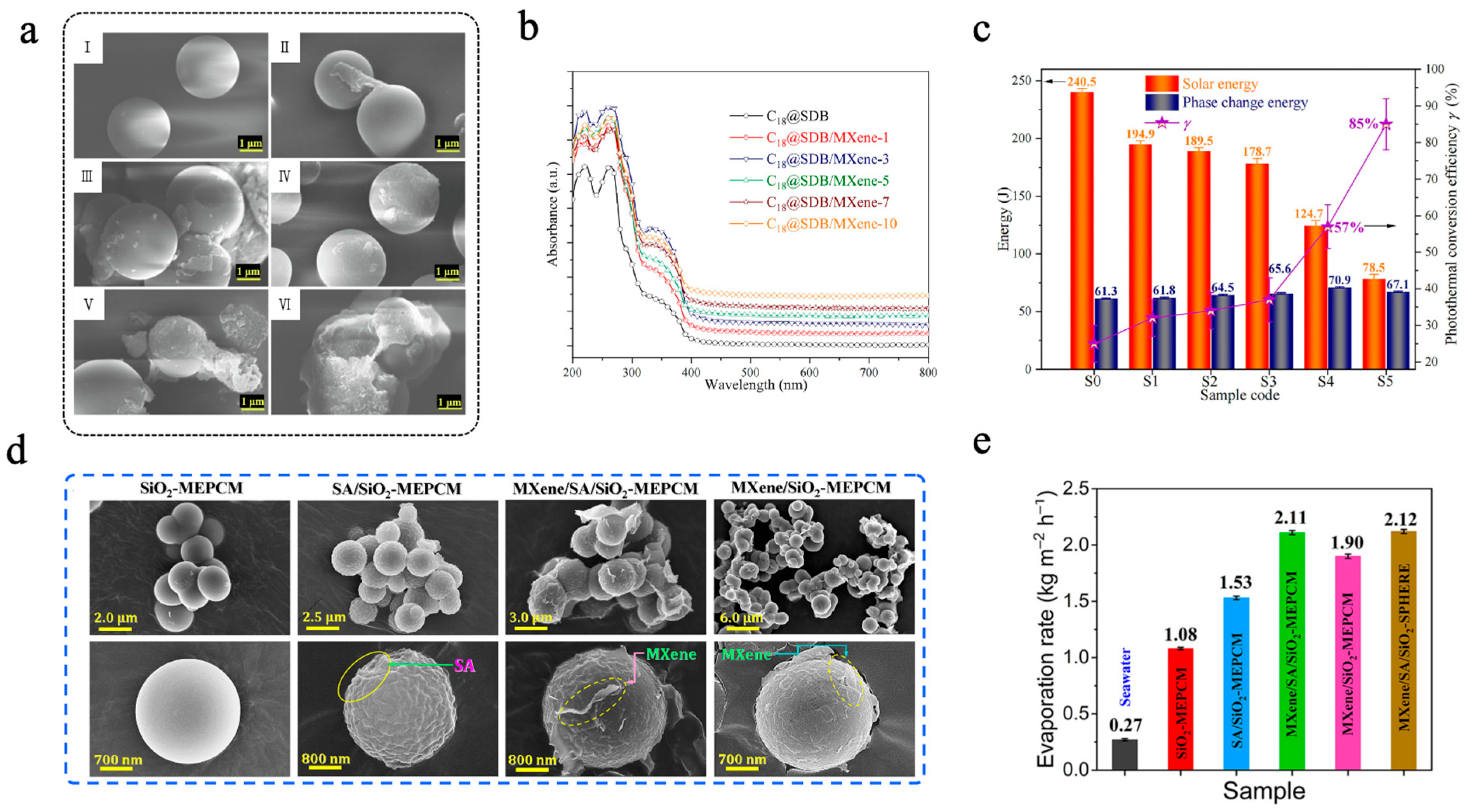


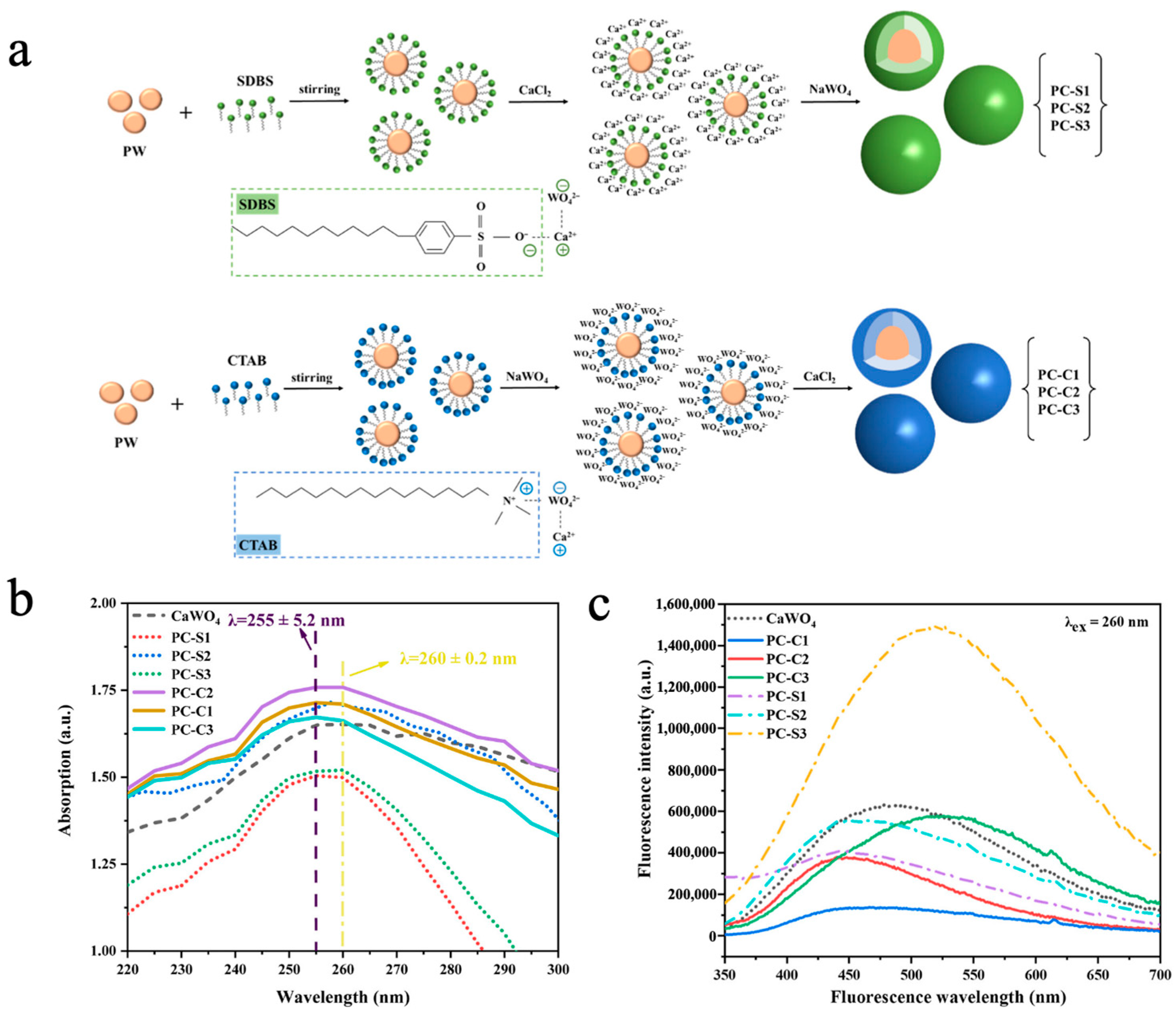
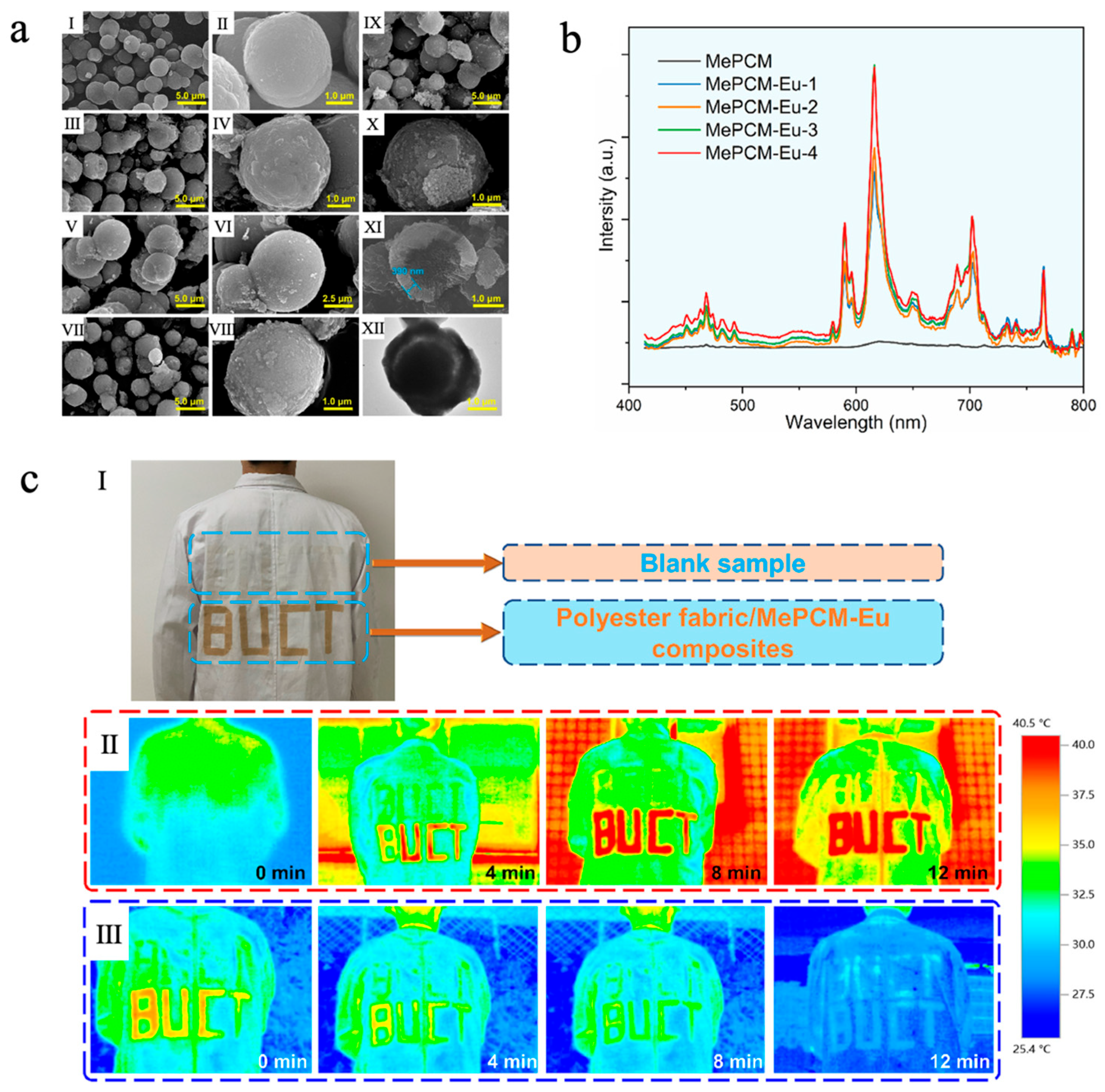
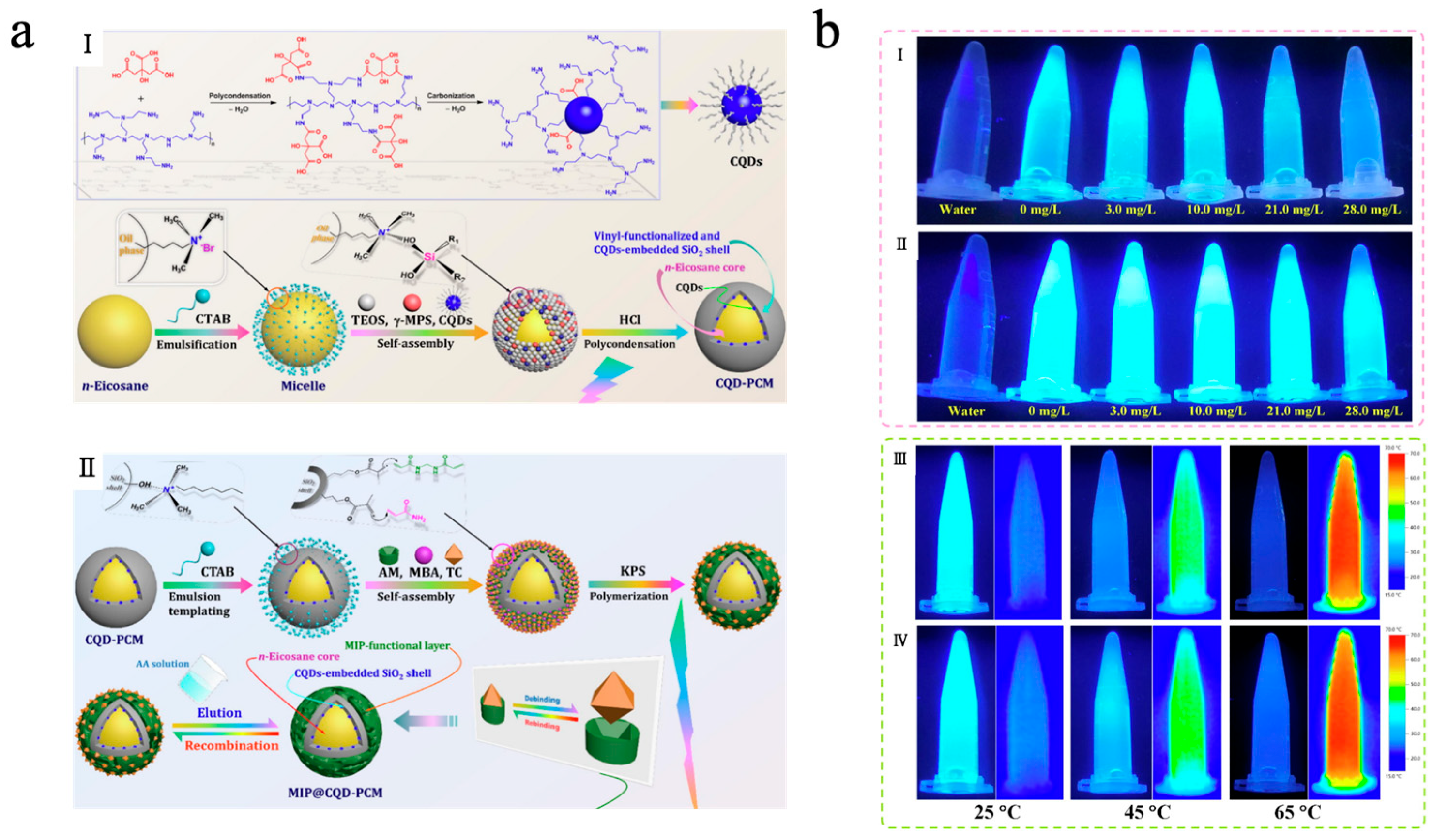
| Category | Typical Materials | Melting Range | Advantages | Limitations | Representative Applications |
|---|---|---|---|---|---|
| Organic PCMs | Paraffins [34,35], polyols, fatty acids [36,37] | Low- to medium-temperature (typically <200 °C) | Chemically stable, non-corrosive, low cost, adjustable melting point | Low thermal conductivity, flammable, low density | Building thermal regulation, textiles, packaging |
| Inorganic PCMs | Salt hydrates [40], metals and their alloys [41,42,43,44] | Low- to high-temperature (approximately 10–800 °C) | High latent heat per volume, high thermal conductivity, non-flammable | Corrosive, prone to supercooling or phase separation, high cost | Industrial heat recovery, solar thermal systems, electronics cooling |
Disclaimer/Publisher’s Note: The statements, opinions and data contained in all publications are solely those of the individual author(s) and contributor(s) and not of MDPI and/or the editor(s). MDPI and/or the editor(s) disclaim responsibility for any injury to people or property resulting from any ideas, methods, instructions or products referred to in the content. |
© 2025 by the authors. Licensee MDPI, Basel, Switzerland. This article is an open access article distributed under the terms and conditions of the Creative Commons Attribution (CC BY) license (https://creativecommons.org/licenses/by/4.0/).
Share and Cite
Yang, C.; Du, B. Recent Advances in Photo-Responsive Microencapsulated Phase-Change Materials. Materials 2025, 18, 5014. https://doi.org/10.3390/ma18215014
Yang C, Du B. Recent Advances in Photo-Responsive Microencapsulated Phase-Change Materials. Materials. 2025; 18(21):5014. https://doi.org/10.3390/ma18215014
Chicago/Turabian StyleYang, Chaofeng, and Binyang Du. 2025. "Recent Advances in Photo-Responsive Microencapsulated Phase-Change Materials" Materials 18, no. 21: 5014. https://doi.org/10.3390/ma18215014
APA StyleYang, C., & Du, B. (2025). Recent Advances in Photo-Responsive Microencapsulated Phase-Change Materials. Materials, 18(21), 5014. https://doi.org/10.3390/ma18215014







